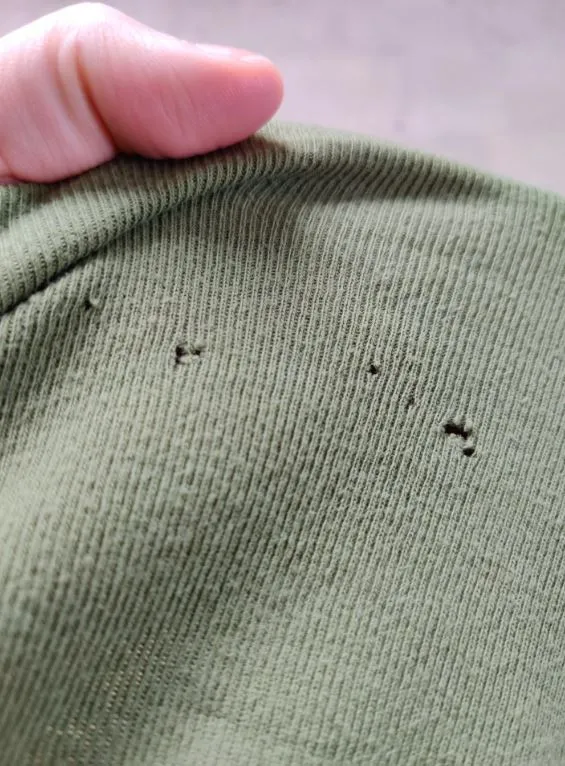Have you ever pulled out your favorite T-shirt, only to find tiny holes clustered near the bottom? If so, you’re not alone. This frustrating problem has puzzled many people for years, with no clear explanation. Recently, a woman’s social media post about her husband’s T-shirts sparked a viral discussion, as she sought advice on why his shirts consistently developed small holes after just a day of wear.
The mystery generated countless theories, from washing machine malfunctions to poor fabric quality. But what is the real cause? Let’s dive into the most likely reasons for these annoying holes, expert insights, and practical solutions to keep your T-shirts hole-free.
A Woman’s Viral Post and the Internet’s Response

The discussion began when a woman posted in the popular Mrs Hinch Cleaning Tips Facebook group. She shared a photo of her husband’s T-shirt with tiny holes near the belly button area and asked, “Why does this always happen to his T-shirts? He can wear a brand new one, and within a day, there are holes. My clothes are fine. Any advice?”
Her question quickly garnered hundreds of comments, with users chiming in with their theories and personal experiences. From friction against jeans buttons to washing machine snags, the responses reflected the shared frustration of dealing with this common issue.
Common Theories Behind the Tiny Holes
The post prompted several plausible explanations for the mysterious holes. Here are the most common theories that social media users shared:
Friction from Jeans Buttons and Belt Buckles
The most widely accepted explanation is friction caused by metal hardware on jeans, such as buttons, rivets, or belt buckles. Many users pointed out that leaning against counters, sinks, or desks can create repeated contact between these metal parts and the bottom of the T-shirt. Over time, this friction wears down the fabric, resulting in tiny holes.
Washing Machine or Dryer Damage
Another popular theory blamed the washing machine or dryer. Sharp edges, loose components, or even zippers from other clothing items can snag delicate fabrics during the washing or drying cycle. One commenter shared, “I used to have this issue until I discovered a loose piece of metal in my dryer. Once we fixed it, the holes stopped appearing.”
Zippers and Rivets on Outerwear
Some users suggested that zippers on hoodies, jackets, or bags could catch on T-shirts, especially during everyday activities. “I’ve noticed these holes when I wear a hoodie with a zip-up front. The T-shirt underneath often gets caught when I zip up quickly,” said one commenter.
Poor Fabric Quality
A few individuals speculated that low-quality fabrics could be more prone to wear and tear. With the rise of fast fashion, many clothing items are made with thinner, less durable materials, making them more susceptible to damage from everyday use.
Experts Weigh In: The Primary Culprit Is Friction
While there are several potential causes for these holes, clothing experts largely agree that friction is the primary culprit. Alison Gary, a stylist and founder of Wardrobe Oxygen, explains, “The pinholes are usually caused by friction against the metal hardware on jeans—your button, rivets, zipper, and even thick threads around the fly can wear down knit T-shirts.”
This friction is most pronounced when individuals lean against hard surfaces, such as countertops or desks. Over time, the repetitive movement weakens the fabric, leading to small holes in the same spot.
Why Does It Happen More to Men’s T-Shirts?
One common question is why this issue seems to affect men’s T-shirts more often than women’s. The answer lies in the fit and design of the clothing. Men’s T-shirts are typically longer and looser, which means the bottom of the shirt is more likely to come into contact with belt buckles or jeans buttons. Women’s tops, on the other hand, are often shorter, more fitted, or worn tucked in, reducing the chance of friction.
Simple Solutions to Prevent T-Shirt Holes
If you’re tired of seeing your favorite T-shirts ruined by tiny holes, don’t worry. There are simple and effective ways to prevent this issue from happening in the future.
Tuck in Your T-Shirt
One of the easiest ways to avoid friction is to tuck your T-shirt into your jeans or pants. Even a half-tuck can create a barrier between the shirt and any metal hardware, protecting the fabric from constant rubbing.

Opt for a Fabric Belt or No Belt
Consider switching to a fabric belt or a buckle-free option. These alternatives eliminate the sharp edges that often rub against T-shirts. If you don’t need a belt, going without one is an even simpler solution.
Inspect Your Washing Machine and Dryer
Take a closer look at your appliances for loose parts, sharp edges, or rough surfaces that could snag your clothes. Fixing these issues or using a laundry bag for delicate items can help protect your T-shirts during the washing and drying process.
Be Careful with Outerwear
When wearing a hoodie, jacket, or bag with zippers, take extra care to avoid catching your T-shirt. Smooth the fabric underneath before zipping up, and consider using bags without metal hardware for everyday use.
Invest in High-Quality Fabrics
If possible, choose T-shirts made from thicker, more durable materials. While they may cost more upfront, high-quality fabrics are less likely to wear down quickly and can save you money in the long run.
The Takeaway: How to Keep Your T-Shirts Looking New
The mystery of tiny holes in T-shirts is no longer unsolved. The main culprit is friction caused by metal hardware like belt buckles, jeans buttons, and zippers. Combined with the occasional snag from washing machines or poor fabric quality, this can lead to frustrating damage.
Fortunately, preventing these holes is as simple as making small adjustments to your habits. Tuck in your T-shirt, switch to gentler belts, inspect your appliances, and handle outerwear with care. By taking these steps, you can enjoy your favorite T-shirts for longer without worrying about annoying, inexplicable holes.
What’s Your Experience? Share Your Thoughts
Have you dealt with this problem before? What’s your theory behind the mysterious T-shirt holes, and have you discovered a solution that works? Share your experience in the comments—we’d love to hear your insights! If you found this article helpful, share it with friends or family who might be dealing with the same issue. Together, we can keep our wardrobes hole-free and looking fresh!


